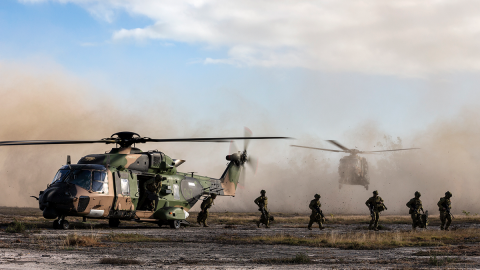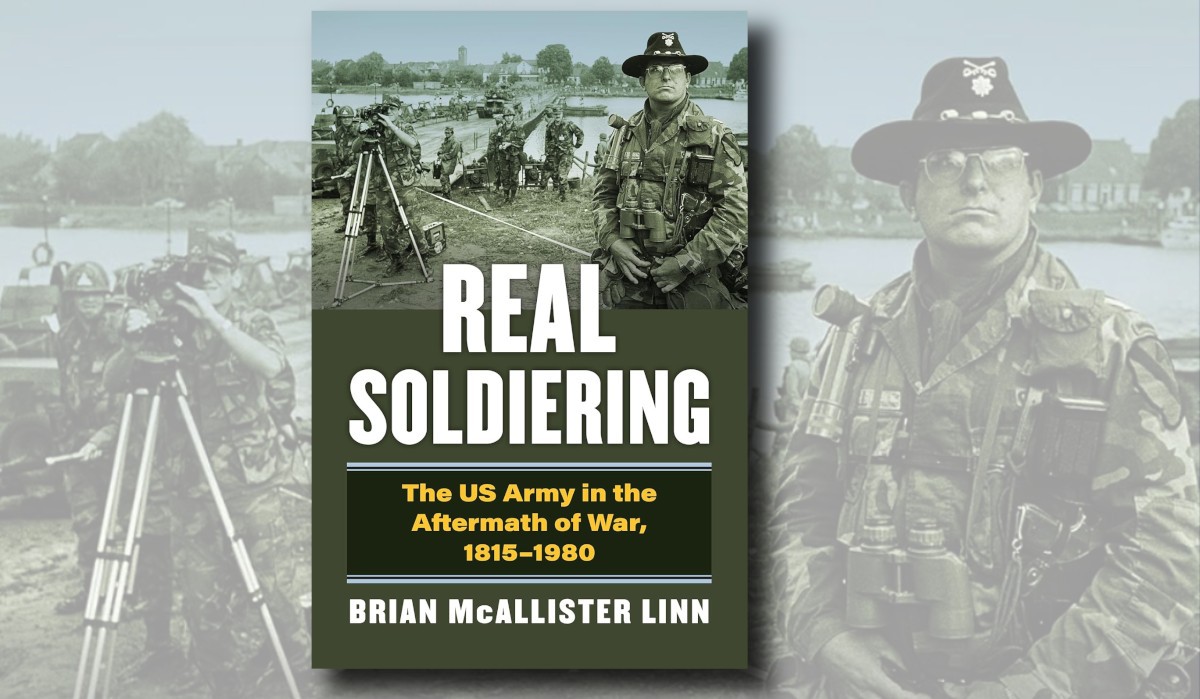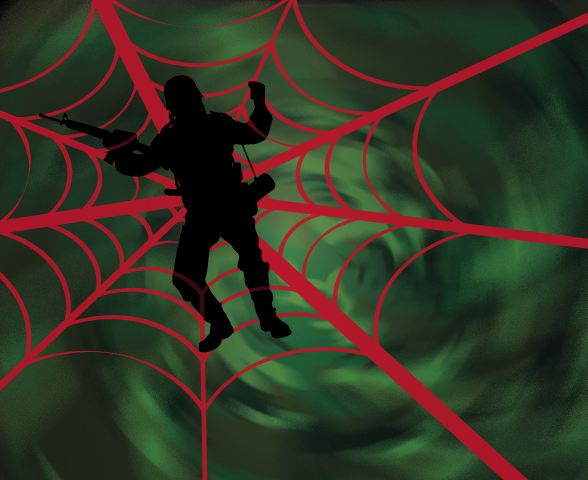Introduction
The ‘greater uncertainty’ in Australia’s strategic environment identified in the 2016 Defence White Paper is now perhaps deterioration, with increasing concerns that we rely on an alliance partner that may become decreasingly willing or able to underwrite our defence. Hugh White has questioned the ADF’s capacity to defend Australia, Concurrently, it is the Chief of Army’s assessment that history’s continuous shift in the character of future warfare is now accelerating. As the geopolitical order shifts in the Indo-Pacific, non-state threats are expanding while information, artificial intelligence and autonomous technologies are democratising warfare and spreading lethality. In response, the Chief directs Army to be ‘ready now’ and ‘future ready’.
What is the nature of preparedness that reconciles the competing demands of ‘now’ and ‘future’ in a rapidly changing world? The notion of a ‘poised force’ may assist. This is one that is highly alert to a capability’s threats and opportunities, has the agility to rapidly field new capabilities from a foundation of position and stance that provides capability latency. To visualise these ideas we might turn to the past.
Poised Forces in the Past: The Reichsheer
The Germans had earlier adopted an organisational philosophy focused on future capability. In the aftermath of WW1 the Versailles treaty slashed the German military, with the Army cut to a ‘contingency force’ 1/20th of its former size, and prohibited it from owning heavy artillery, tanks or even a General Staff. Despite monitored restrictions and a small budget, the Reichsheer was deliberately developed as the foundation for an army to win a future war.
Concurrently, the victors took a peace-dividend, with Britain assuming a rolling ten-year warning time for war and reducing its Army to an imperial policing force, while the more anxious French embraced the defensive ‘Maginot’ strategy. When the threat from an assertive Japan and Hitler’s resurgent Germany became undeniable, Britain’s rearmament was desperate, built on an incoherent base and arguably so delayed as to compel Prime Minister Neville Chamberlain’s maligned appeasement policy of 1937/38.
In contrast to British disorder, the Reichsheer systematically expanded and efficiently used a smaller pool of resources to become the Wehrmacht of 1939. This was still a mostly marching and horse-drawn force, but the combination of an insert of modern technologies such as the Panzer and dive-bomber, excellent doctrine and a robust military culture enabled it to sweep opponents before it for three years. How did an emasculated contingency force provide the base for a qualitatively superior army?
The most common explanation given for German success is the iron determination of the post-WW1 military leadership under General Hans von Seeckt, with the drastic Versailles constraints serving to concentrate quality in a professional force, and demand ‘clean sheet’ approaches. Furthermore, Metz[1] has pointed out that rather than simply ‘tolerating eccentricity’ (as the Allies did with De Gaulle, Liddell-Hart and Fuller) the Germans empowered their visionaries. The Reichsheer was philosophically and structurally poised to build new capability: it was positioned and took up a stance for change. Almost a century later and a hemisphere away, we might aspire to a comparable purpose.
I propose a conceptual model to support analysis of and debate over balancing preparedness between ready now and future ready. The construct offered is ‘capability poise’ which describes a force that is able to grow existing capability, and deliver new capabilities. The term poise conjures notions of an athlete, predator or warrior able to accelerate suddenly. It implies the ability to move in any new direction, not just towards predictable destinations. Poise also infers a carefully selected location of advantage from which as many different objectives as possible can be reached. So why do we need a new approach?
The Need for Poise
There are three reasons for a new framework to examine capability. First, Accelerated Warfare recognises that new threats will emerge faster than the existing procurement processes can deliver capability to counter them. This is an unprecedented challenge. Second, changing strategic circumstances might require that the ADF rapidly changes to project much greater combat power, independently sustain major operations or defend continental territory—all requirements incompatible with a small, highly professional full-time force. Third, the record suggests that funding shortages may require hard choices that include adjusting some capabilities downward.
The balance of investment in current versus future capability has always been a crucial strategic choice for leaders, as new technologies have often determined the outcomes of war. However it is decreasingly possible to make reliable choices about which systems will give future advantage or be needed to counter new threats. The rate of technological change, especially in information technology and artificial intelligence, means that adversaries may field new capabilities with little or no warning. This is happening at a time when technical complexity and institutional factors have slowed the introduction of ADF systems. The risk of being technically surprised by enemy capability overmatch or finding our capabilities suddenly obsolescent appears substantial. Furthermore, the social, economic and political changes driven by the same technology shifts are diversifying violent conflict, with non-state and proxy actors empowered by technology, leading to increasing instability and volatility. Future tasks are increasingly hard to discern.
The Nature of Poise
The notion of poise attempts to address this dilemma. Poise is not just a balanced set of capabilities or the means to develop predicted capabilities. It incorporates the means to develop unforeseen capabilities. There are three elements to poise:
- Alertness – the discernment to anticipate and act with speed
- Agility – the ability to respond, develop and incorporate new capability
- Positioning and Stance – the choice of current and latent capabilities
Alertness describes the philosophical readiness and intellectual capacity to use limited cues to make early capability decisions. These decisions variously consider, progress, commit to, increase, decrease or retire capability. This may require new decision processes that are fed by strong links from intelligence and defence science. Accelerated Warfare will demand that such decisions are made before certainty is possible, as occurs on the battlefield, and therefore capability leaders will not only require intuitive and analytic skills but greater tolerance of error. The risk of poor choices must be mitigated by hedging with multiple capabilities and accepting inefficiency. Less intuitively, an organization—and particularly its leadership—can only be alert if it is not totally immersed in current tasks. There is strong evidence that for effective responsiveness key elements should not be expected to routinely operate above 80% of their maximum effort.
Agility is the technical and intellectual capacity for rapidly developing novel capability. Its enduring foundations are education and training, but Accelerated Warfare demands—and technology can now enable—equally accelerated procurement, enabled by new technologies such as additive manufacturing. Paradigms of procurement may need to change, with industry working physically and philosophically closer to military users in order to tighten the development loop. Indeed, military formations might incorporate sub-units who themselves rapidly develop and build equipment (as has already occurred to counter IEDs). Such rapid fielding of capability requires both technology-enabled accelerated training methods and a workforce with the education and foundational skills to train rapidly. A crucial part of agility is normalising continuous ‘testing and trialling’ of new equipment and techniques.
Positioning and Stance means choosing which capabilities are maintained, at what levels of readiness, with a focus on latency for responding to accelerating warfare. It assumes that a minimum level of essential capabilities are held at short notice to move. Beyond this all other capability systems are chosen with an emphasis on the suitability of their constituent elements as foundations for diverse and/or new capability. This approach prioritises capabilities whose elements are reconfigurable or have long lead times. For example, a system that is multipurpose or modular might be favoured over one with superior performance in a specific application. Similarly, a system where many of the training competencies could be applied in other systems might be favoured over a system which demands personnel specialisation. Functional duplication and thus ‘inefficiency’ might be accepted to hedge against emerging threats. As a concrete example, low level air defence capability might be delivered with a mix of missile, directed energy and cannon systems, cognisant of the proven utility of the latter for ground close combat. Effective positioning and stance requires mapping the whole of land warfare capability as a linked system of systems, with the status of all component elements of capability as inputs. The capacity for continuous assessment of current capability against both specified tasks/response options and an updated set of scenarios would offer transparent risk management to Government.
Conclusion
The notion of poise is not revolutionary. It must still rest on current and foreseeable capability requirements generated in the current manner, albeit that it emphasises integration and modularity. It is simply a different way of analysing the problem of striking a balance between future and current capability which may better prepare Army for accelerated war.
[1] Metz, Steven. Strategy and the Revolution in Military Affairs: From Theory to Policy. DIANE Publishing, 1995. P36




